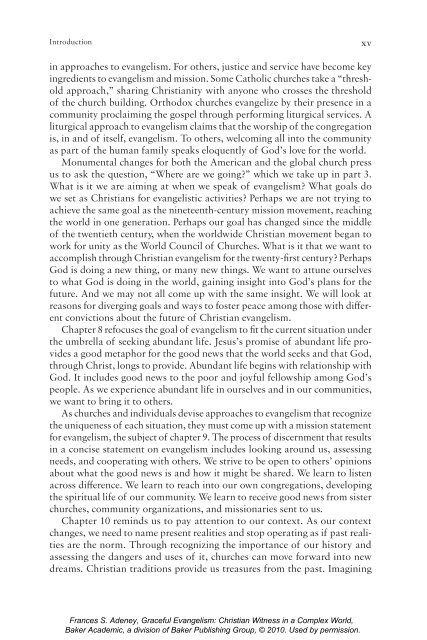Graceful EvanGElism - Baker Publishing Group
Graceful EvanGElism - Baker Publishing Group
Graceful EvanGElism - Baker Publishing Group
You also want an ePaper? Increase the reach of your titles
YUMPU automatically turns print PDFs into web optimized ePapers that Google loves.
Introductionxvin approaches to evangelism. For others, justice and service have become keyingredients to evangelism and mission. Some Catholic churches take a “thresholdapproach,” sharing Christianity with anyone who crosses the thresholdof the church building. Orthodox churches evangelize by their presence in acommunity proclaiming the gospel through performing liturgical services. Aliturgical approach to evangelism claims that the worship of the congregationis, in and of itself, evangelism. To others, welcoming all into the communityas part of the human family speaks eloquently of God’s love for the world.Monumental changes for both the American and the global church pressus to ask the question, “Where are we going?” which we take up in part 3.What is it we are aiming at when we speak of evangelism? What goals dowe set as Christians for evangelistic activities? Perhaps we are not trying toachieve the same goal as the nineteenth-century mission movement, reachingthe world in one generation. Perhaps our goal has changed since the middleof the twentieth century, when the worldwide Christian movement began towork for unity as the World Council of Churches. What is it that we want toaccomplish through Christian evangelism for the twenty-first century? PerhapsGod is doing a new thing, or many new things. We want to attune ourselvesto what God is doing in the world, gaining insight into God’s plans for thefuture. And we may not all come up with the same insight. We will look atreasons for diverging goals and ways to foster peace among those with differentconvictions about the future of Christian evangelism.Chapter 8 refocuses the goal of evangelism to fit the current situation underthe umbrella of seeking abundant life. Jesus’s promise of abundant life providesa good metaphor for the good news that the world seeks and that God,through Christ, longs to provide. Abundant life begins with relationship withGod. It includes good news to the poor and joyful fellowship among God’speople. As we experience abundant life in ourselves and in our communities,we want to bring it to others.As churches and individuals devise approaches to evangelism that recognizethe uniqueness of each situation, they must come up with a mission statementfor evangelism, the subject of chapter 9. The process of discernment that resultsin a concise statement on evangelism includes looking around us, assessingneeds, and cooperating with others. We strive to be open to others’ opinionsabout what the good news is and how it might be shared. We learn to listenacross difference. We learn to reach into our own congregations, developingthe spiritual life of our community. We learn to receive good news from sisterchurches, community organizations, and missionaries sent to us.Chapter 10 reminds us to pay attention to our context. As our contextchanges, we need to name present realities and stop operating as if past realitiesare the norm. Through recognizing the importance of our history andassessing the dangers and uses of it, churches can move forward into newdreams. Christian traditions provide us treasures from the past. ImaginingFrances S. Adeney, <strong>Graceful</strong> Evangelism: Christian Witness in a Complex World,<strong>Baker</strong> Academic, a division of <strong>Baker</strong> <strong>Publishing</strong> <strong>Group</strong>, © 2010. Used by permission.
















